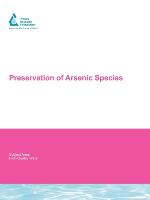Preservation of Arsenic Species
BücherAngebote / Angebote:
In order to establish effective treatment removal strategies for arsenic, it is important to know the actual concentrations of As(III) and As(V) in drinking waters. Due to its anionic character, As(V) can be removed more easily than As(III). The distribution of As(III) and As(V) species depends greatly on the abundance of redox-active solids, especially organic carbon, the activity of microorganisms, and the extent of diffusion of O2 from the atmosphere. In strongly reducing aquifers, As(III) is the dominant species based on the thermodynamic considerations, whereas As(V) is the more stable oxidation state under oxic conditions or in oxygenated waters.
Based on extensive experimental results in Fe(II)-contaminated challenge water, it was found that EDTA-HAc could be used to preserve the arsenic species for at least 28 days in opaque plastic bottles. Although the alternative preservatives, H2SO4 and H3PO4, successfully preserved the original As(III)/(V) speciation under some conditions, these preservatives were generally unsuccessful for the desired 28-day period under reducing and oxidizing conditions in the sample pH range of 6.5?V8.4 and in the presence of 3 mg/L Fe(II).
A comprehensive, systematic study was conducted to determine the effect of ferrous iron on the stability of arsenic species. Among the promising preservatives described in the literature, H2SO4, H3PO4, EDTA, and EDTA-HAc were chosen for this study. The combined results of two AwwaRF arsenic analysis projects?oField Speciation Method for Arsenic Inorganic Species and this project, Preservation of Arsenic Species have yielded a method for immediate field-speciation and a preservation technique for speciation within 30 days of sampling. Limited field verifications of these methods, which give statistically indistinguishable results, have been completed.
Folgt in ca. 15 Arbeitstagen




